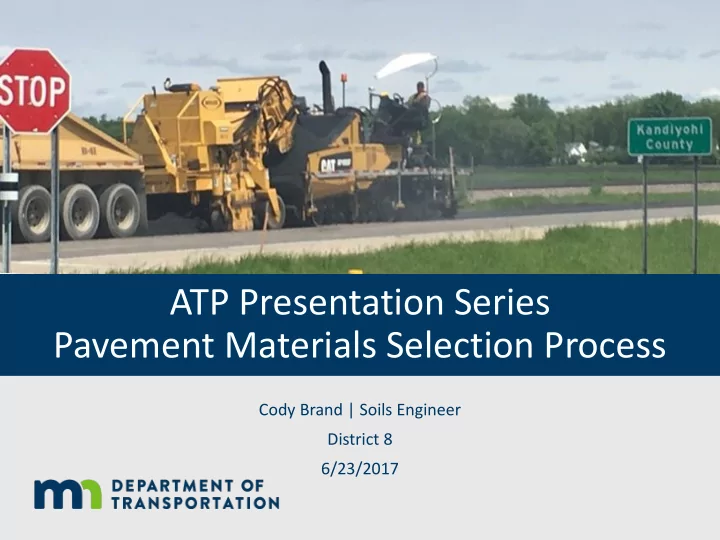

ATP Presentation Series Pavement Materials Selection Process Cody Brand | Soils Engineer District 8 6/23/2017
ATP Presentation Series 1. MnDOT Statewide Planning 2. Performance Measures & Funding Programs a) Pavement & Materials Selection Process You are here! 3. Project Selection Processes 4. Project Scoping 5. STIP Overview and Approval Process 2
Overview • Reconnaissance • Current & Predicted Pavement Conditions • Effects of Pavement Resurfacing • Cost of Pavement Resurfacing • Network Analysis • Project Selection 3
Reconnaissance • Historic Plans • Technical Information • Falling Weight Deflectometer (FWD) • Coring • Past Pavement Condition • Projected Pavement Condition Focus For Today 4
Pavement Conditions "Good" Ride Quality Index, Non-Interstate NHS System (RQI > 3.0) Actual 2016 Predicted 2021 (2018-2021 STIP) Predicted 2027 (2022-2027 CHIP) 100% 90% 88.7% 86.1% 80% Percent of Roadway Miles 78.5% 74.4% 74.4% 70% 73.8% 73.1% 73.2% 72.2% 71.9% 71.5% 71.7% 71.4% 70.5% 69.2% 68.4% 68.5% 66.4% 64.7% 60% 61.3% 60.6% 60.4% 58.0% 57.9% 56.9% 56.6% 55.0% 50% 40% 30% 20% 10% 0% ATP-1 ATP-2 ATP-3 ATP-4 ATP-6 ATP-7 ATP-8 Metro Statewide 5
Pavement Conditions "Poor" Ride Quality Index, Non-Interstate NHS System (RQI <= 2.0) Actual 2016 Predicted 2021 (2018-2021 STIP) Predicted 2027 (2022-2027 CHIP) 20% 18% 16% Percent of Roadway Miles 14% 12% 10.9% 10% 10.4% 9.6% 8% 8.8% 8.8% 8.0% 7.9% 6% 6.8% 6.4% 5.9% 5.5% 5.2% 5.0% 4% 4.8% 4.8% 4.4% 4.1% 3.8% 0.8% 0.8% 0.7% 3.0% 2% 1.9% 1.7% 2.0% 1.6% 1.5% 0% ATP-1 ATP-2 ATP-3 ATP-4 ATP-6 ATP-7 ATP-8 Metro Statewide 6
Pavement Conditions "Good" Ride Quality Index, Non-NHS System (RQI > 3.0) Actual 2016 Predicted 2021 (2018-2021 STIP) Predicted 2027 (2022-2027 CHIP) 100% 90% 85.1% 80% Percent of Roadway Miles 77.6% 76.7% 75.7% 74.8% 70% 73.9% 73.7% 73.2% 71.4% 70.1% 69.5% 67.9% 67.1% 65.8% 65.2% 60% 63.9% 63.3% 63.4% 62.8% 62.1% 58.0% 57.6% 50% 53.7% 49.2% 49.0% 40% 40.8% 34.8% 30% 20% 10% 0% ATP-1 ATP-2 ATP-3 ATP-4 ATP-6 ATP-7 ATP-8 Metro Statewide 7
Pavement Conditions "Poor" Ride Quality Index, Non-NHS System (RQI <= 2.0) Actual 2016 Predicted 2021 (2018-2021 STIP) Predicted 2027 (2022-2027 CHIP) 30% 26.6% 25% Percent of Roadway Miles 20% 17.5% 16.3% 15% 13.3% 12.7% 12.7% 10% 9.3% 9.1% 9.0% 9.0% 8.9% 8.4% 8.2% 8.3% 5% 6.1% 6.0% 5.5% 1.0% 4.8% 4.8% 1.0% 0.6% 4.3% 3.4% 2.5% 3.1% 3.9% 0% ATP-1 ATP-2 ATP-3 ATP-4 ATP-6 ATP-7 ATP-8 Metro Statewide 8
Projecting Pavement Conditions Ride Quality Index Year 9
Projecting Pavement Conditions Ride Quality Index Year 10
Defining “Pavement Condition” • Measures include: • Ride Quality Index (RQI) • Remaining Service Life (RSL) • Surface Rating (SR) • Crack Counts What the Public Sees 11
Pavement Distress Identification 12
Effects of Resurfacing • Examine performance of: • Major Rehabilitation Paver • Cold In-place Recycle (CIR) • Medium mill & overlay • Thin Surface Treatments • Ultra-thin Bonded Wearing Course (UTBWC) 5/8” – 1.0” • Micro-milling Thickness 13
Low Severity Transverse cracks / 500’ Effects of Resurfacing - CIR Year 18 + years 14
Low Severity Transverse cracks / 500’ Effects of Resurfacing – Medium M&O Year 11 years 15
Cost of Resurfacing • Cold In-place Recycle • $ 250,000 / mile • Detour may be needed • CIR mix design may need to be performed by a consultant • CIR doesn’t work well in urban sections • Medium Mill and Overlay • $ 225,000 / mile • Detour not required 16
Cost of Resurfacing • Full Depth Reclamation / Stabilized Full Depth Reclamation • $ 350,000 / mile • Detour required • Ground Penetrating Radar should be performed by consultant • White-topping • $ 300,000 – $ 600,000 / mile • Detour required • Ground Penetrating Radar should be performed by consultant • More complex deliverability 17
Effects of Resurfacing – UTBWC No Ultra-Thin Bonded Ultra-Thin Bonded Wearing Course Wearing Course Ride Quality Index Year Year 18
Effects of Resurfacing – Micro-milling Year 0 RQI Year 1 RQI Year 3 RQI Micro-mill & Chip Seal 3.3 3.4 3.4 Micro-mill & Micro-Surfacing* 2.3 3.7 3.2 Micro-mill & UTBWC 2.9 3.9 3.5 NRRA micro-milling case study on 3 MN trunk highways between 2013 – 2016. *Polymer Modified Micro-Surfacing • RQI on traditional mill and overlay projects ranges from 4.2 – 3.6 • Other Thin Surface Treatments to Consider: • Double chip seal • ThinLay 19
Cost of Resurfacing • Ultra-thin Bonded Wearing Course • $ 100,000 / mile • Potential for snow and ice issues in wind-blown locations • Micro-milling • $ 15,000 / mile (additional cost) • ThinLay • $ 65,000 / mile 20
Benefits of Thin Surface Treatments • Program Flexibility • Can be advanced or delayed with minimal impact • No profile raise: • Reduces the cost of shouldering • Reduces the cost of entrances / intersection • Preserves in-slope • “Easy” deliverability • Design and Inspection • Shorter duration 21
Network Analysis • Highway Pavement Management Application (HPMA) • Uses a decision tree to determine the appropriate rehabilitation strategy for each segment. Triggers include: • Ride Quality Index • Surface Rating • Transverse Cracking • Alligator Cracking • Fiscal constrains are used to determine the most cost effective projects 22
23
Project Selection • HPMA network analysis is verified or revised by District • Past project performance • Recent regional experience • Research and literature • Projects are selected based on funding targets and performance measures • Process is repeated annually for program development • Also repeated within the fiscal year 24
Thank you! Questions? Cody Brand Cody.Brand@state.mn.us 320-214-6366 25
Recommend
More recommend